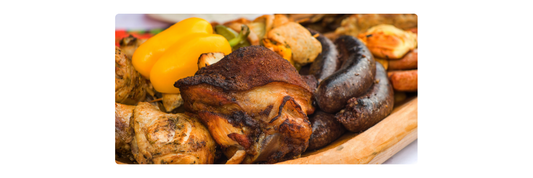Acidic foods are a common part of many diets but consuming them in excess can lead to health issues such as acid reflux, GERD, and tooth erosion. Balancing your diet to include less acidic foods can improve overall health and reduce discomfort. In this blog, we'll explore some of the most acidic foods people commonly eat and provide tips for achieving a low acid diet.
Common Acidic Foods

- Citrus Fruits: Oranges, lemons, limes, and grapefruits are highly acidic and can exacerbate acid reflux and heartburn. Pure citrus juices, like your morning OJ or afternoon lemonade, are obvious sources, however many dressings and marinades can also contain citrus juices. Love Lemonade? Read our Low Acid Lemonade Recipes blog!
- Tomatoes: Both fresh tomatoes and tomato-based products like sauces and soups are acidic and often trigger symptoms in sensitive individuals. This includes everything from pizza and red sauces for pasta, to ketchup and barbecue sauce. Don’t let acid ruin your summer barbecue! Read our summer grilling blog.
- Carbonated Beverages: Sodas and sparkling waters contain carbonic acid, which can contribute to acid build-up in the stomach.
- Coffee: Although many people rely on their morning coffee, it is acidic and can irritate the stomach lining. Many coffee drinkers like to enjoy more than one cup, which can cause additional, compounding irritation.
- Alcohol: Beer and wine are acidic and can weaken the esophageal muscles that control the flow of air and food, leading to acid reflux. Cocktails and mixers can contain citrus, carbonation, and other acid-inducing ingredients.
- Chocolate: Chocolate can vary in acidity due to its origin, processing and other factors, but it does contain ingredients, including caffeine, that can relax the esophageal muscles, resulting in heartburn.
- Processed Foods: Processed foods often contain preservatives and additives that increase acidity levels.
- Dairy Products: While not as acidic as other foods, some dairy products can contribute to acid formation in the stomach.
Tips for a Low Acid Diet
Achieving a low acid diet involves making mindful food choices and incorporating lifestyle changes. Here are some practical tips to help you get started:
Increase Alkaline Foods:

- Vegetables: Most vegetables are low in acid and high in fiber, which aids digestion. Leafy greens, cucumbers, and broccoli are excellent choices.
- Fruits: Opt for non-citrus fruits like bananas, melons, and apples. These are generally lower in acid.
- Nuts and Seeds: Almonds, flaxseeds, and chia seeds are good options as they are less likely to trigger acid reflux.
- Use CalciBlend: Sprinkle CalciBlend on foods to reduce acidity before digestion. CalciBlend is made with calcium, potassium, and magnesium. Our patented all-natural formula is designed for effective delivery throughout the entire digestive system. That means including CalciBlend in your diet provides oral, esophageal, stomach, and urinary tract support.
Modify Cooking Methods:
- Bake or Steam: Instead of frying, bake or steam your food to reduce the need for acidic condiments and spices.
- Avoid Spicy Seasonings: Use herbs like basil, thyme, and parsley instead of hot spices to flavor your food.
Drink Alkaline Beverages:
- Water: Plain water is the best choice for staying hydrated without increasing acidity.
- Herbal Teas: Chamomile and ginger tea can be soothing for the stomach.
- Almond Milk: A non-acidic alternative to cow’s milk.
- Large, calorie dense meals can cause increased acid production in the stomach. Eating smaller, more frequent meals can help prevent excess acid, and ultimately, heartburn.
- Give your body time to digest by not eating at least two to three hours before lying down.
- Curb your intake of alcoholic beverages. If you enjoy wine, use Wine Tamer to reduce the acid.
- Use Coffee Tamer with each cup of coffee to reduce up to 90% of acids. Herbal teas or chicory coffee can be great substitutes to coffee if you are looking to curb your overall intake.
- Keep a food diary to track which foods trigger your symptoms and adjust your diet accordingly. Everyone’s body reacts differently, so personal adjustments are crucial.
Conclusion

Transitioning to a low acid diet doesn't mean you have to give up all your favorite foods. By making informed choices and slight modifications, you can enjoy a balanced diet that promotes better digestive health. Start by incorporating more alkaline foods, adjusting your cooking methods, and being mindful of your eating habits. Over time, these small changes can lead to significant improvements in your overall well-being.
References
American Dental Association. "Diet and Oral Health." American Dental Association, 2019, www.ada.org/resources/research/science-and-research-institute/oral-health-topics/diet-and-oral-health. Accessed 29 May 2024.
Johns Hopkins Medicine. "GERD Diet: Foods That Help with Acid Reflux (Heartburn)." Johns Hopkins Medicine, 2020, www.hopkinsmedicine.org/health/wellness-and-prevention/gerd-diet-foods-that-help-with-acid-reflux-heartburn. Accessed 29 May 2024.
Harvard Health Publishing. "Dietary Acid Load and Health." Harvard Medical School, 2018, www.health.harvard.edu/blog/dietary-acid-load-and-health-2019021815761. Accessed 29 May 2024.
Mayo Clinic. "GERD Diet: Foods to Eat and Avoid." Mayo Clinic, 2022, www.mayoclinic.org/diseases-conditions/gerd/expert-answers/gerd-diet/faq-20058476. Accessed 29 May 2024.
Cleveland Clinic. "How to Reduce Your Acid Reflux." Cleveland Clinic, 2019, health.clevelandclinic.org/3-ways-to-prevent-acid-reflux-naturally/. Accessed 29 May 2024.




